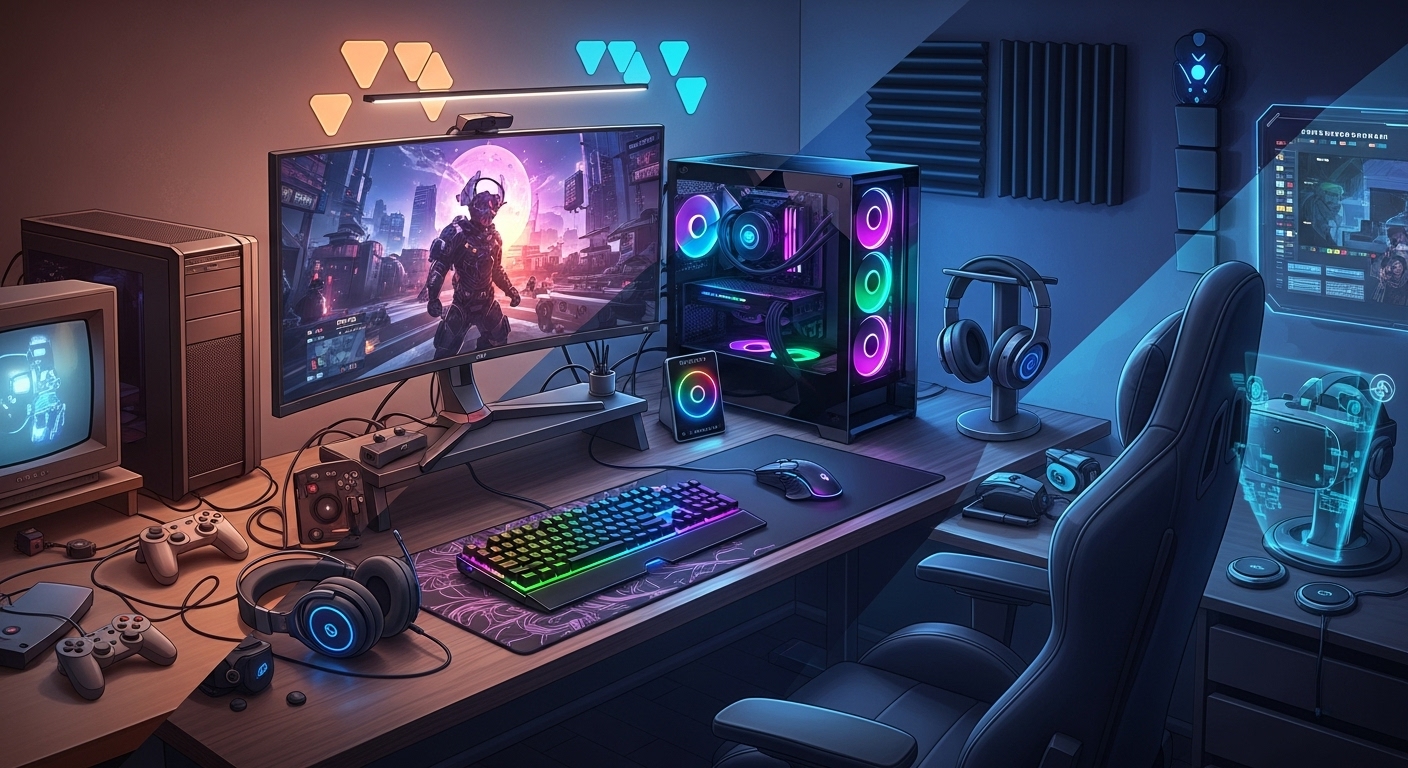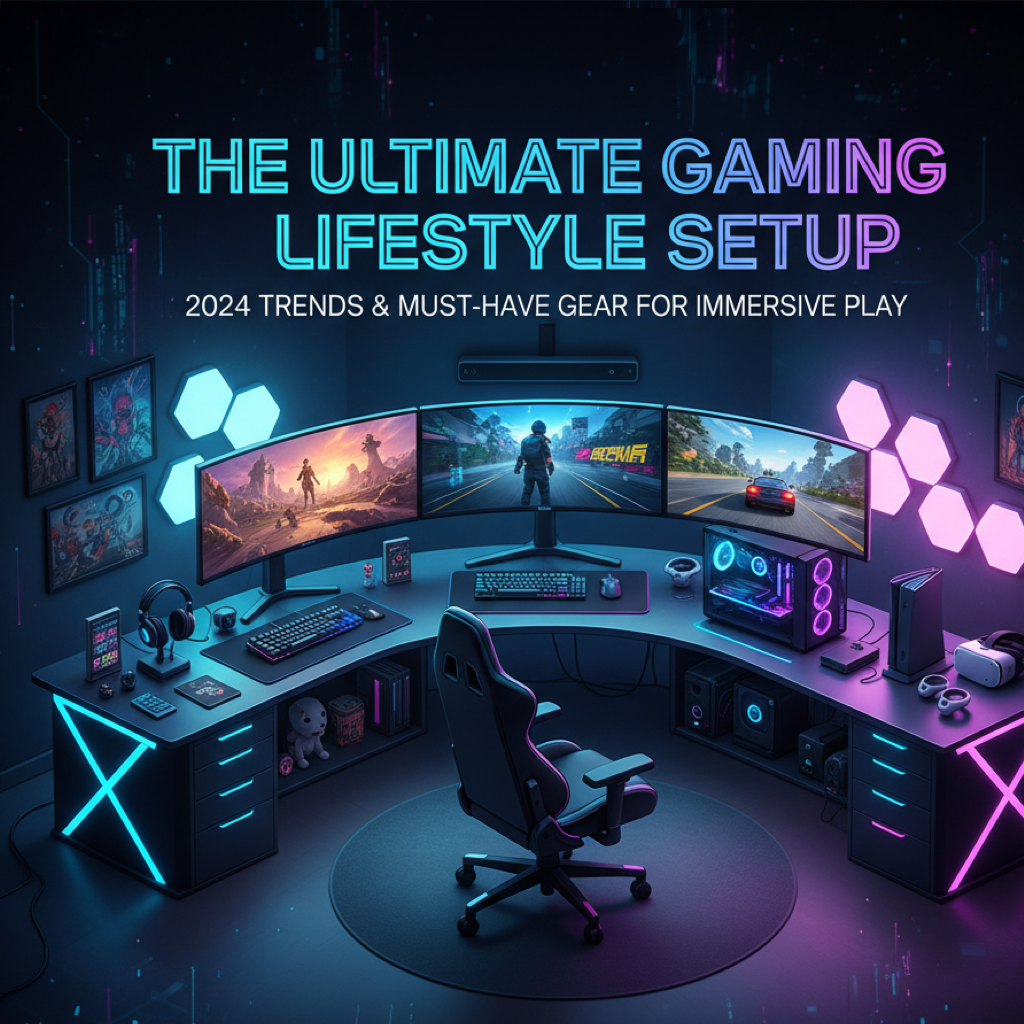The Humble Beginnings: A Trip Down Memory Lane
Remember the days when a gaming setup was simply a console plugged into the family’s bulky CRT television? We’d sit on the floor, controller wires stretching precariously across the living room, a bowl of snacks balanced on a cushion. The environment didn’t matter; only the game did. This was the genesis of the home gaming experience, a shared, often chaotic space where the magic happened on-screen, not around it. The early days of the gaming lifestyle were defined by passion and accessibility, not aesthetics or ergonomics.
The Console on the Floor Era
For many of us, our first foray into gaming involved a Nintendo, Sega, or PlayStation console. The setup was makeshift at best. The console itself might be on a dusty shelf or directly on the carpet. Wires for power, AV cables, and controllers created a tangled web that was a constant trip hazard. Seating was whatever was available – the edge of the sofa, a beanbag chair, or just the floor itself. It was pure, unadulterated fun, focused entirely on the gameplay. The idea of a ‘dedicated’ gaming space was a luxury few could imagine.
The First Dedicated PC Desks
As PC gaming gained traction, the concept of a dedicated spot began to emerge. However, these early ‘battlestations’ were a far cry from what we see today. We’re talking about heavy, beige computer towers humming away under a generic wooden or particleboard desk. The centerpiece was a massive, power-hungry CRT monitor that took up half the desk space and could probably double as a boat anchor. Peripherals were basic: a clunky membrane keyboard and a two-button mouse with a little rubber ball inside that needed constant cleaning. Cable management was a myth. It was a functional space, born out of necessity, but it was the first step toward personalizing the gaming experience and carving out a corner of the world just for our digital adventures.
The Rise of the Battlestation: Function Meets Form
The transition from a simple desk to a full-fledged ‘battlestation’ marked a pivotal moment in the evolution of the gaming lifestyle. Gamers began to realize that the environment they played in had a direct impact on their performance, comfort, and overall enjoyment. It was no longer enough to just have the hardware to run the games; the entire setup needed to be optimized. This era saw a boom in products designed specifically for gamers, shifting the focus from pure function to a harmonious blend of function and form.
Ergonomics Becomes King
Hours-long gaming sessions on a rickety office chair or a dining room stool started to take their toll. Back pain, wrist strain, and general discomfort became common complaints. The industry responded, and ergonomics became the new watchword. High-backed, racecar-style gaming chairs with lumbar support and adjustable armrests became iconic. We saw the rise of sit-stand desks, allowing players to change their posture without interrupting their game. Monitor arms became a staple, letting users position their screens at the perfect height and angle to reduce neck strain. This focus on health and well-being was a clear sign that gaming was evolving from a casual hobby into a serious, long-term lifestyle.
The Power of Peripherals
Peripherals transformed from simple input devices into high-performance, customizable tools of the trade. The satisfying click-clack of mechanical keyboards, with their various switch types catering to different preferences, replaced mushy membrane keys. Gaming mice evolved to feature ultra-precise sensors, adjustable DPI settings, and programmable buttons for macros and shortcuts. Headsets went from delivering tinny audio to providing immersive, 7.1 surround sound that could give players a competitive edge by allowing them to pinpoint enemy footsteps. These weren’t just accessories anymore; they were extensions of the player, critical components for anyone serious about their gaming performance.
Multi-Monitor Madness
Why have one screen when you can have two? Or three? The multi-monitor setup became a hallmark of the serious gamer and streamer. It wasn’t just for show; it was for efficiency. One screen could be dedicated to the game, providing an immersive, panoramic view. A second monitor could display Discord, a stream chat, or a game guide, allowing for seamless multitasking. For content creators, a third monitor for streaming software and OBS was a game-changer. This expansion of digital real estate transformed the gaming desk into a true command center, boosting both immersion and productivity.
The Aesthetic Revolution: Your Setup, Your Identity
As setups became more functional and powerful, the next frontier was aesthetics. The modern gaming setup is more than just a collection of hardware; it’s a form of self-expression. It’s a curated space that reflects the personality, tastes, and passions of its owner. Social media platforms like Instagram, Reddit (r/battlestations), and Pinterest became galleries showcasing stunningly beautiful and unique setups, inspiring a global movement towards personalized and visually appealing gaming environments. The gaming lifestyle now had a distinct and customizable look.
The RGB Phenomenon
You can’t talk about modern gaming aesthetics without mentioning RGB (Red, Green, Blue) lighting. What started with a few glowing LEDs on a mouse has exploded into a full-blown phenomenon. Keyboards, PCs, fans, mousepads, headsets, and even desks and chairs now come equipped with customizable RGB. But it’s more than just a disco show. Coordinated lighting can create a specific mood or ambiance, transforming a room to match the game being played. It can be a subtle underglow or a vibrant, pulsating light show. It’s personalization at its most luminous.
Minimalism vs. Maximalism
Two dominant design philosophies emerged from this aesthetic revolution. On one side, you have the minimalists. Their setups are characterized by clean lines, a neutral color palette, and an almost obsessive approach to cable management. Wires are hidden, desktops are clutter-free, and every item has a purpose. It’s a sleek, sophisticated look that emphasizes focus and tranquility. On the other side are the maximalists. Their spaces are vibrant celebrations of their fandoms, filled with collectibles, Funko Pops, posters, and art. It’s a cozy, personalized den that proudly displays the owner’s passions. Neither approach is ‘better’—they are simply different ways gamers express their identity through their space.
Beyond the Desk: Room Integration
The modern setup no longer stops at the edge of the desk. It now encompasses the entire room. Smart lighting panels like Nanoleaf or Govee Glide create dynamic wall art that can sync with the action on screen. Acoustic panels, once relegated to recording studios, are now used to improve in-game audio and reduce echo, often doubling as decorative elements. Shelving units display game collections and memorabilia. The gaming setup has become the centerpiece of the room, a fully integrated and immersive environment designed for the ultimate gaming lifestyle.
The Future of the Gamer’s Sanctuary
The evolution is far from over. As technology continues to advance at a breakneck pace, the gaming setups of tomorrow will look and feel very different from today’s. The push is towards a more seamless, intuitive, and immersive experience that blurs the lines between the digital and physical worlds.
The Cable-Free Dream
The ultimate goal for any clean setup enthusiast is a completely wireless experience. We’re already well on our way with high-performance wireless mice, keyboards, and headsets that rival their wired counterparts. The next steps include wireless charging built directly into desks and mousepads, and perhaps even wireless display and power technologies that will finally let us sever the last few cords tying our PCs to the wall.
Seamless Integration with Smart Homes
Imagine a setup that’s fully integrated with your smart home ecosystem. You could say, “Hey Alexa, it’s game time,” and your PC would boot up, your smart lights would dim to your preferred gaming preset, and your smart blinds would close. Game developers could even create integrations that cause your room’s lighting to flash red when you take damage or pulse with color during a dramatic cutscene. This level of environmental integration will take immersion to a whole new level.
The Rise of VR/AR Spaces
As virtual and augmented reality technology becomes more mainstream, our physical spaces will need to adapt. A VR-centric setup might require more open floor space for movement, with furniture that can be easily moved or reconfigured. AR could overlay digital elements onto our physical world, turning our entire room into a game level. The desk may become less important as our interaction with the digital world becomes more physical and spatially aware.
Build Your Ultimate Gaming Lifestyle Hub
From a console on the floor of the family room to a fully integrated, aesthetically curated smart room, the journey of the gaming setup has been incredible. It mirrors the evolution of gaming itself—from a niche hobby to a dominant cultural force. Your setup is no longer just a place to play games; it’s your command center, your content creation studio, your social hub, and a direct reflection of your personal gaming lifestyle.
Whether you’re a minimalist who craves a clean workspace or a maximalist who loves to be surrounded by your passions, the most important thing is to create a space that you love. A space that is comfortable, functional, and inspires you to be the best gamer you can be. Take the time to plan, to personalize, and to build a sanctuary that is uniquely yours.
What’s the one piece of gear you can’t live without in your setup? Is it your ergonomic chair, your ultra-wide monitor, or that one collectible that ties the whole room together? Share your thoughts in the comments below and let’s inspire each other!


